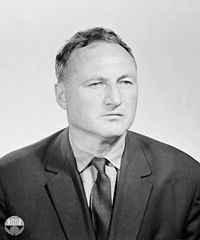
Yuri Linnik
Encyclopedia

Mathematician
A mathematician is a person whose primary area of study is the field of mathematics. Mathematicians are concerned with quantity, structure, space, and change....
active in number theory
Number theory
Number theory is a branch of pure mathematics devoted primarily to the study of the integers. Number theorists study prime numbers as well...
, probability theory
Probability theory
Probability theory is the branch of mathematics concerned with analysis of random phenomena. The central objects of probability theory are random variables, stochastic processes, and events: mathematical abstractions of non-deterministic events or measured quantities that may either be single...
and mathematical statistics
Mathematical statistics
Mathematical statistics is the study of statistics from a mathematical standpoint, using probability theory as well as other branches of mathematics such as linear algebra and analysis...
.
Linnik was born in Bila Tserkva
Bila Tserkva
Bila Tserkva is a city located on the Ros' River in the Kiev Oblast in central Ukraine, approximately south of the capital, Kiev. Population 203,300 Area 34 km².-Administrative status:...
, in present-day Ukraine
Ukraine
Ukraine is a country in Eastern Europe. It has an area of 603,628 km², making it the second largest contiguous country on the European continent, after Russia...
. He went to St Petersburg University where his supervisor was Vladimir Tartakovski, and later worked at that university and the Steklov Institute
Steklov Institute of Mathematics
Steklov Institute of Mathematics or Steklov Mathematical Institute is a research institute based in Moscow, specialized in mathematics, and a part of the Russian Academy of Sciences. It was established April 24, 1934 by the decision of the General Assembly of the Academy of Sciences of the USSR in...
. He was a member of the Russian Academy of Sciences
Russian Academy of Sciences
The Russian Academy of Sciences consists of the national academy of Russia and a network of scientific research institutes from across the Russian Federation as well as auxiliary scientific and social units like libraries, publishers and hospitals....
, as was his father, Vladimir Pavlovich Linnik. He was awarded both State
USSR State Prize
The USSR State Prize was the Soviet Union's state honour. It was established on September 9, 1966. After the breakup of the Soviet Union, the prize was followed up by the State Prize of the Russian Federation....
and Lenin Prize
Lenin Prize
The Lenin Prize was one of the most prestigious awards of the USSR, presented to individuals for accomplishments relating to science, literature, arts, architecture, and technology. It was created on June 23, 1925 and was awarded until 1934. During the period from 1935 to 1956, the Lenin Prize was...
s. He died in Leningrad
Leningrad
Leningrad is the former name of Saint Petersburg, Russia.Leningrad may also refer to:- Places :* Leningrad Oblast, a federal subject of Russia, around Saint Petersburg* Leningrad, Tajikistan, capital of Muminobod district in Khatlon Province...
.
Work in number theory
- Linnik's theoremLinnik's theoremLinnik's theorem in analytic number theory answers a natural question after Dirichlet's theorem on arithmetic progressions. It asserts that, if we denote p the least prime in the arithmetic progressiona + nd,\...
in analytic number theory - The dispersion method (which allowed him to solve the Titchmarsh problem).
- The large sieve (which turned out to be extremely influential).
- An elementary proof of the Hilbert-Waring theoremWaring's problemIn number theory, Waring's problem, proposed in 1770 by Edward Waring, asks whether for every natural number k there exists an associated positive integer s such that every natural number is the sum of at most s kth powers of natural numbers...
; see also Schnirelmann densitySchnirelmann densityIn additive number theory, the Schnirelmann density of a sequence of numbers is a way to measure how "dense" the sequence is. It is named after Russian mathematician L.G...
. - The Linnik ergodic method, see , which allowed him to study the distribution properties of the representations of integers by integral ternary quadratic forms.
Infinitely divisible distributions
Linnik obtained numerous results concerning infinitely divisible distributionsInfinite divisibility (probability)
The concepts of infinite divisibility and the decomposition of distributions arise in probability and statistics in relation to seeking families of probability distributions that might be a natural choice in certain applications, in the same way that the normal distribution is...
. In particular, he proved the following generalisation of Cramér's theorem: any divisor of a convolution of Gaussian and Poisson random variables is also a convolution of Gaussian and Poisson.
He has also coauthored the book on the arithmetics of infinitely divisible distributions.
Central limit theorem
- Linnik zones (zones of asymptotic normality)
- Information-theoreticInformation theoryInformation theory is a branch of applied mathematics and electrical engineering involving the quantification of information. Information theory was developed by Claude E. Shannon to find fundamental limits on signal processing operations such as compressing data and on reliably storing and...
proof of the central limit theoremCentral limit theoremIn probability theory, the central limit theorem states conditions under which the mean of a sufficiently large number of independent random variables, each with finite mean and variance, will be approximately normally distributed. The central limit theorem has a number of variants. In its common...

